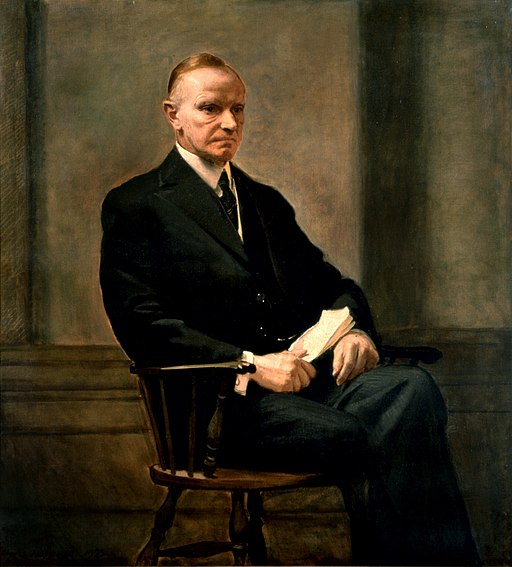John Fifeld or Fifield, Yeoman of Littleton, Hampshire
Lets start, not at the beginning, but at the end, with his Last Will and Testament.
The following is my attempt to transcribe the probate entry of that Will obtained from The National Archives.
Johannis Fifield - John Fifield
In the Name of God Amen
The fifth day of October 1653 I John Fifield of Littleton in the county of Southampton, Yeoman being in perfect memory thanks be to God xxx xxx this my last Will and Testament in in manner and form following that is to say First I commit my soul into the hands of the Almighty God my xxx xxx him through the xxx of my Saviour Jesus Christ by his blood shed and xxx xxx if blameless and to xxx xxx xxx to not annoy it or hurt it And my body to the Earth thou to xxx xxx xxx xxx of my Saviour Jesus Christ and to be buried at the xxx of my Executer hereinafter mentioned that is to say in xxx xxx xxx xxx of Littleton xxx xxx xxx xxx goods and xxx and xx personal Estate my minds and Will is as followeth.
Item I give and bequeath to the stock of the poor of the parish of Littleton the sum of xxx shillings and eight pence and xxx xxx for the poor of from xxx to xxx.
Item I give and bequeath to my son John Fifield the sum of Twenty Shillings
Item I give and bequeath to my son Robert Fifield the sum of Ten Pounds
Item I give and bequeath to my son William Fifield the sum of Ten Pounds
Item I give and bequeath to my son George Fifield the sum of Ten Pounds
Item I give and bequeath to my son Edward Fifield the sum of Twenty Shillings
Item I give to all by xxx children Forty Shillings apiece being in xxx xxx xxxx
Item I give and bequeath to xxx my dearly beloved wife xxx xxx xxx my stock and household xxx that is upon my own xxx within door and without and xxx xxx and all other and to be equally divided between her and my Executor Except one grass granary in the Kitchen and the Table board in the hall and the Salting trough and through my Will is that xxx xxx xxx standards to the xxx.
Item I give and bequeath to my daughter Elizabeth Hitton wife of Robert Hitton the sum of Twenty Shillings
Item I give and bequeath to John Sharp the son of Edward Sharp the sum of Twenty Shillings and xxx my Will is that my funeral charges be paid by my Executor and which Paid Several Sums and xxxxx my Will is that it be paid within one year of my xxx (death) and that all the rest of my Lands, goods and chattels and personal Estate my debts and funeral charges being paid I give and bequeath to Richard Fifield my youngest son whom I make Executor of this my last Will and Testament paying all xxx all the rest of my Estate xxx xxx I do appoint John Smith and Robert Hitton to be my observers of this my last Will and Testament and for their xxx my Will is that they should have xxx Shillings and Eight pence (Six Shillings and Eight pence ??) apiece In witness xxx hereunto set my hand and xxx John Fifield make his mark applied in the presence of John Duplin xxx
This Will was proved at London xxx xxx and Eighteenth Day of January In the year of our Lord God one Thousand Six Hundred and Fifty Four (English Style) before the judge for Wills and granting administrations lawfully authorized xxx the Oath of Richard Fifield the youngest son and sole Executor named in the said Will To whom administration of all and singular the goods and chattels and debts of the said deceased was granted …
From the Will it appears that John Fifield died in between October 1653 and January 1654.
Surviving him were sons John, Robert, William, George, Edward and Richard together with a daughter Elizabeth and John's dearly beloved, but un-named wife. Richard Fifield, his youngest son is made Executor of the Will.
The daughter Elizabeth is married and could be considered in that time to be the responsibility of her husband, but she still receives the sum of Twenty Shillings, which is one Pound.
There is no Estate or Lands mentioned in the Will so presumably he was a tenant and not a landowner.
Beyond the Last Will and Testament
Where is Littleton?
It is in the county of Hampshire, sometimes know as the County of Southampton, within Budlesgate Hundred. It is North of Winchester, the ancient capital of England, and slightly to the West.
A series of old maps follow, focused of Littleton.
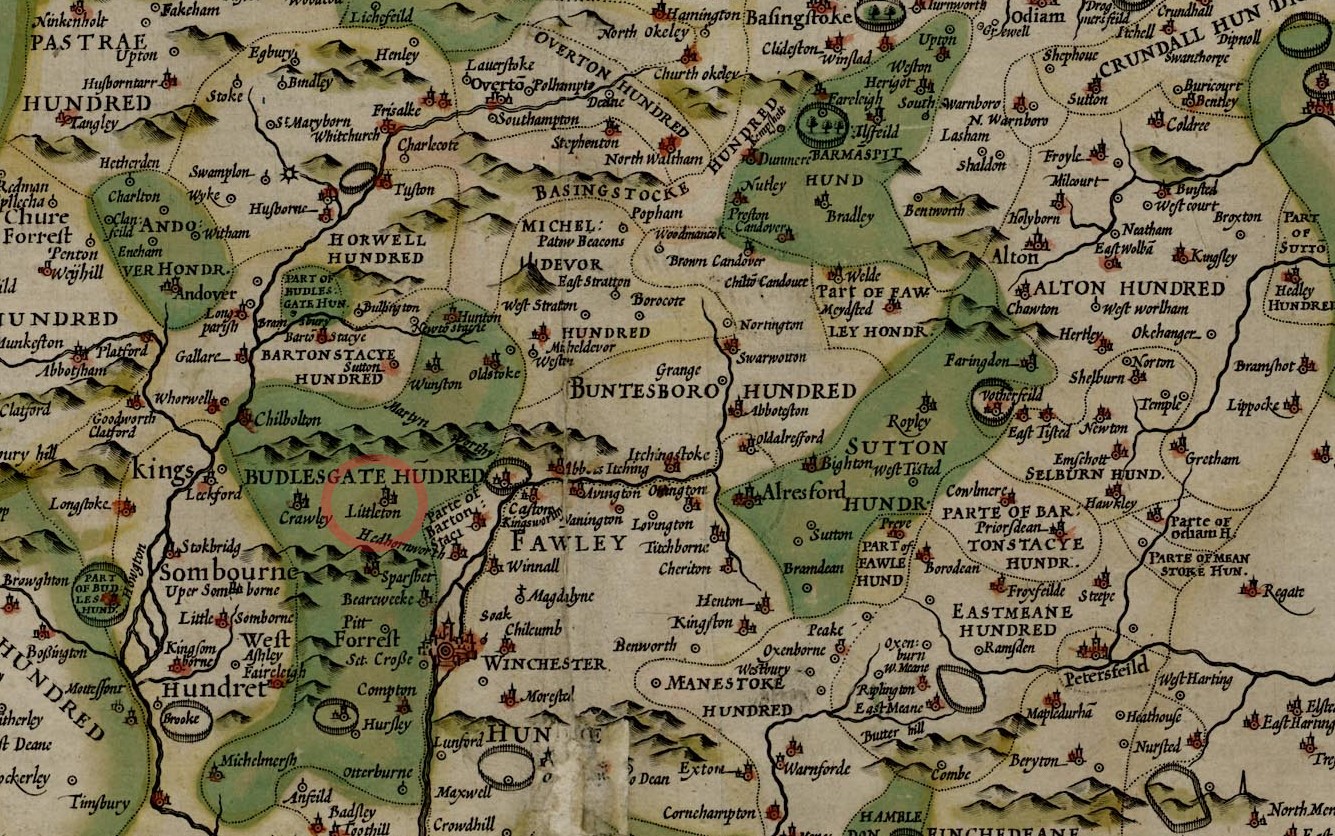 Speed's Map of Hampshire 1611 - Littleton in the Budlesgate Hundred circled
Speed's Map of Hampshire 1611 - Littleton in the Budlesgate Hundred circled
 Morden's Map of Hampshire 1695 - Littleton circled in red and Crawley in blue
Morden's Map of Hampshire 1695 - Littleton circled in red and Crawley in blue
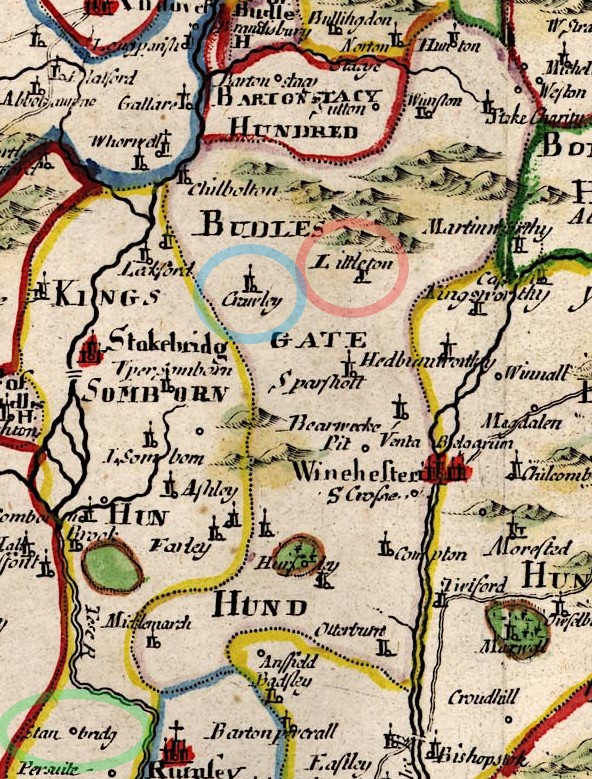 Morden's Map of Hampshire 1695 - Budlesgate Hundred - Littleton circled in red and Crawley in blue. Stan bridg in green bottom left near Rumfey (Now Romsey)
Morden's Map of Hampshire 1695 - Budlesgate Hundred - Littleton circled in red and Crawley in blue. Stan bridg in green bottom left near Rumfey (Now Romsey)
Littleton is the stated home of the Yeoman, John Fifield. It is shown on the earliest map shown in this group, Speed's Map of Hampshire 1611, and is the focus on the following maps as we move through time towards the present.
John Fifield died in between October 1653 and January 1654 so Speed's map is contemporaneous with John Fifield's early life.
Stepping on past his death, is Morden's Map of Hampshire 1695 - Littleton is circled in red and Crawley in blue. Crawley is mentioned as a possible birth place for other Fifield's but not yet part of John's story.
Form the same map but with a different view. we can still see Littleton and Crawley in the Budlesgate Hundred. To the South lies Winchester. Further South, towards the bottom of the image, the following places can be found.
Barton peverall, the name of the school I attended for sixth form, whist living in Romsey.
Eastley, now known as Eastleigh, and the location of Barton Peveril School.
Rumfey, where the f is an s, would then be written as Rumsey and now known as the town of Romsey, one of my childhood homes.
Slightly to the West of Romsey, circled in green is Stan bridg. This is the location of the later Standbridge, an Estate found later in the Fifield Family History.
Jumping forward again is Taylor's Map of Hampshire 1795. No need to circle Littleton this time. Also showing Winchester, Crawley, Headbourne Worthy, Week, and Sparsholt. All places of interest either within the Fifield Family or with regard to my Family Tree more generally.
Then a different image of the same Taylor's Map of Hampshire 1795 but further South, to Romsey, with Stanbridge circled in green again. The clearly demonstrates that place names can evolve and change over time. This is also true of surnames.
Finally, in this set of non Ordinance Survey old maps is Greenwood's Map of Hampshire 1826 showing Littleton, with Northwood and Lainston House. It also shows some named Farms. Throughout this series of maps the constant advances and improvements in map making is very evident, together with the enhanced detail.
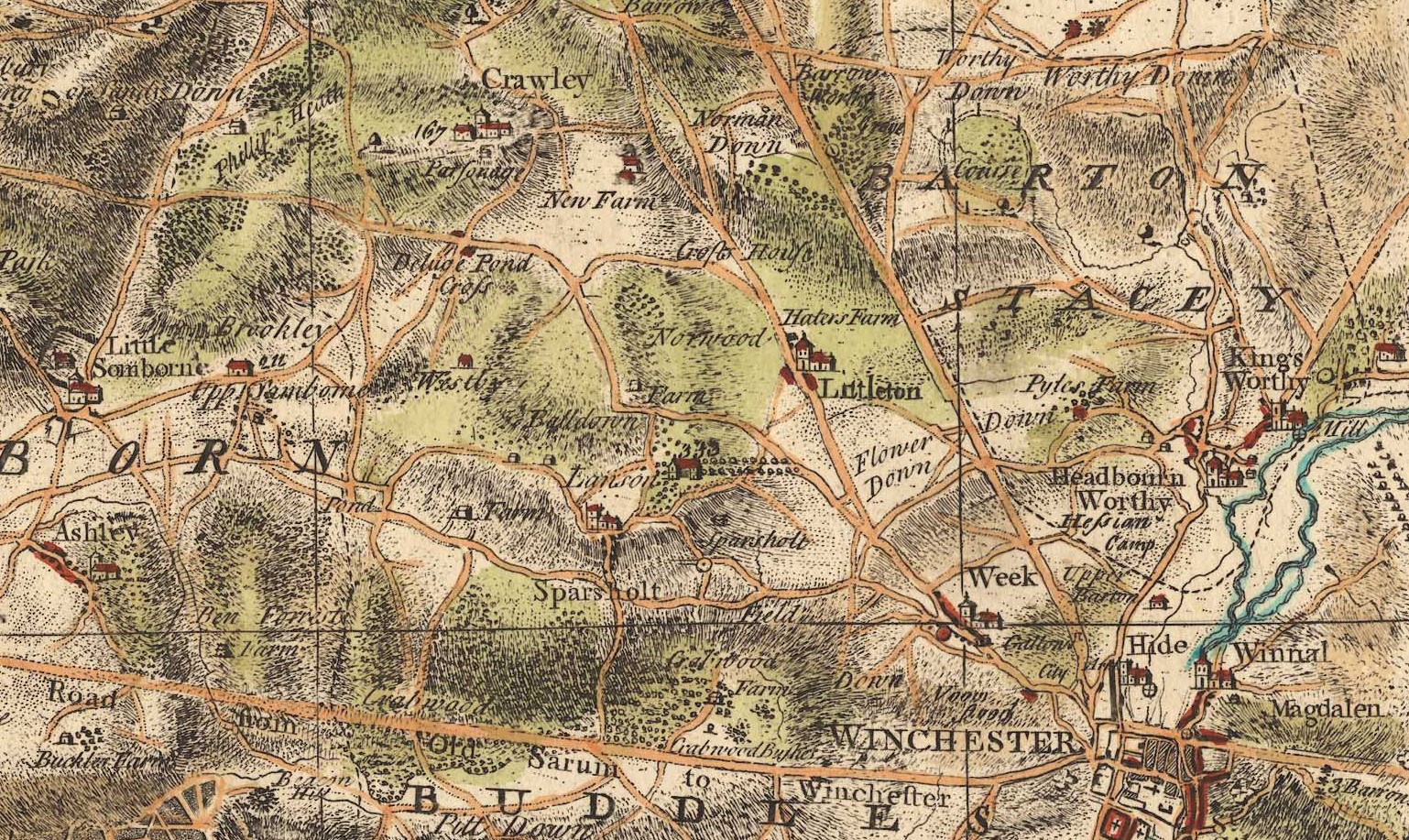 Taylor's Map of Hampshire 1795 - Littleton. Also showing Winchester, Crawley, Headbourne Worthy, Week, and Sparsholt
Taylor's Map of Hampshire 1795 - Littleton. Also showing Winchester, Crawley, Headbourne Worthy, Week, and Sparsholt
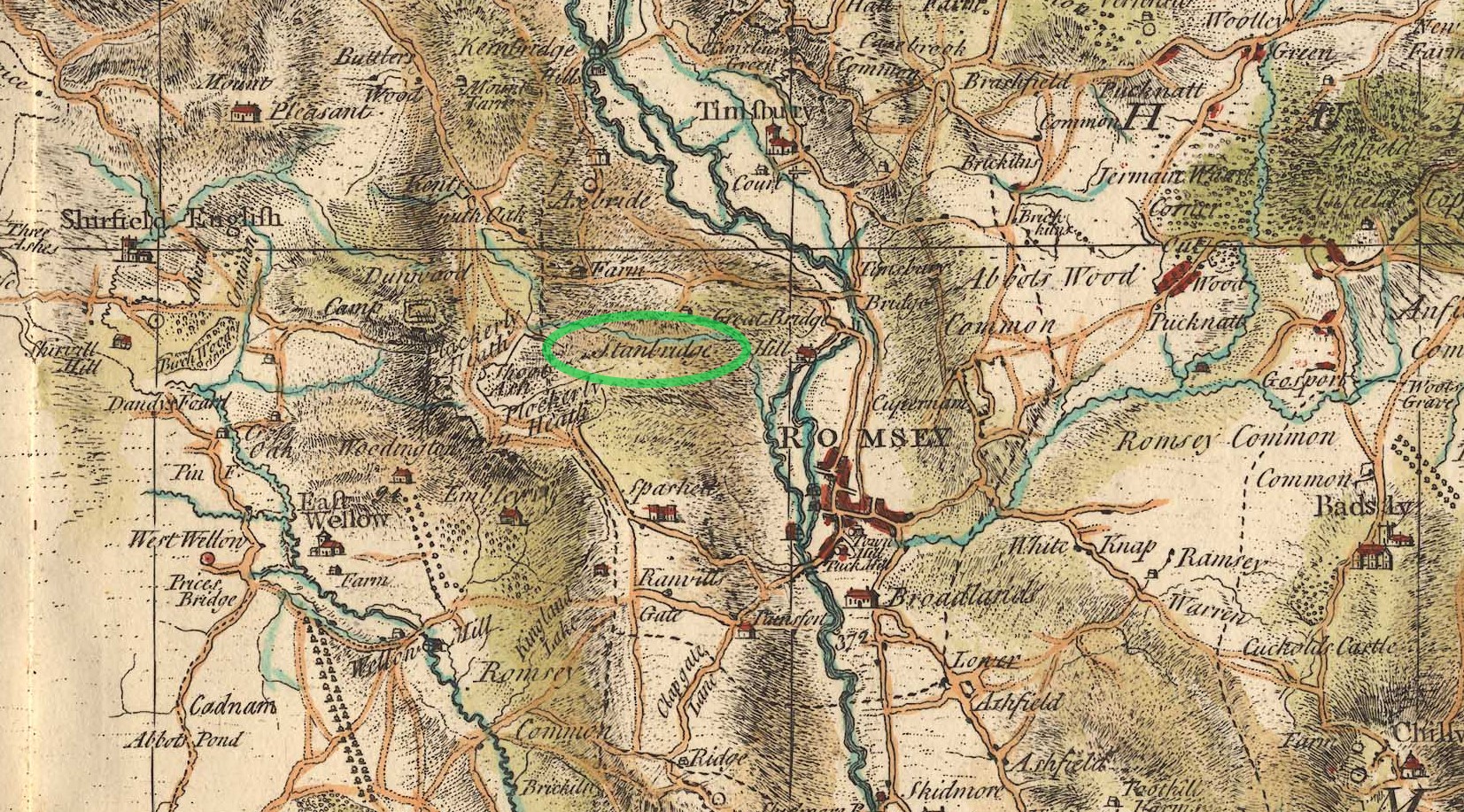 Taylor's Map of Hampshire 1795 - Stanbridge
Taylor's Map of Hampshire 1795 - Stanbridge
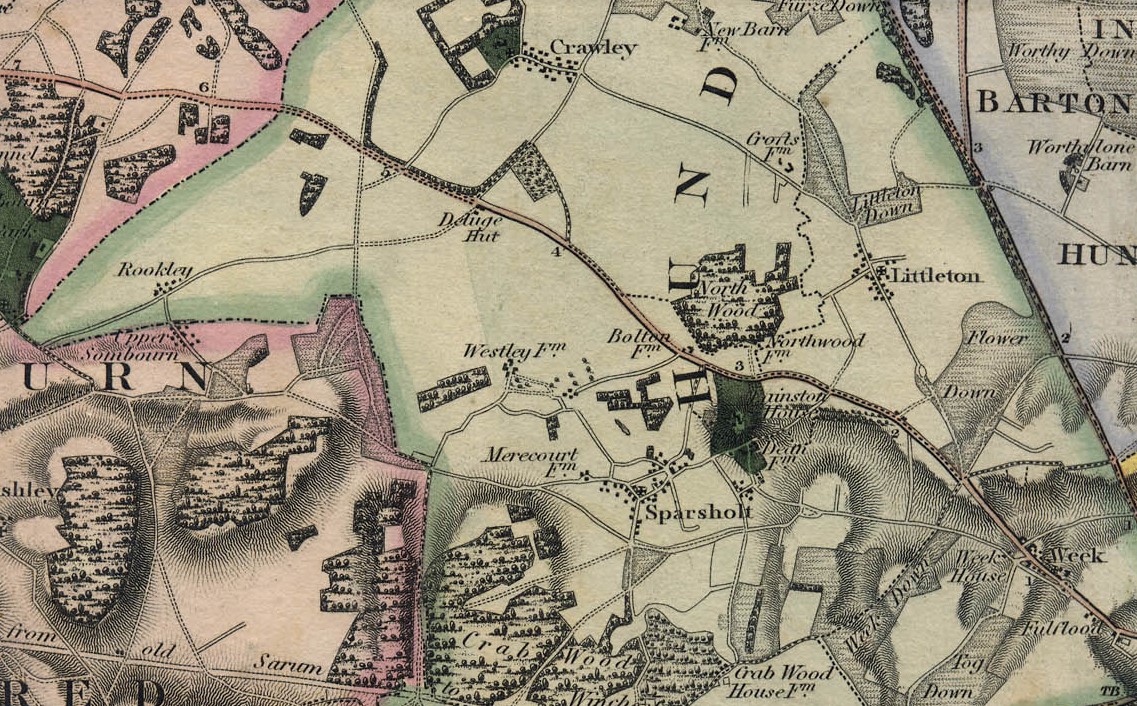 Greenwood's Map of Hampshire 1826 - Littleton, with Northwood and Lainston House. Also some named Farms.
Greenwood's Map of Hampshire 1826 - Littleton, with Northwood and Lainston House. Also some named Farms.
More recent Ordinance Survey maps of the 25" to the mile scale.
Starting with an image zoomed in on the village of Littleton, with significant level of detail. The zooming out to revel the relative position of Littleton and the surrounding area. Click of any of the maps to open the original source in a new window. The OS maps are from the National Library of Scotland.
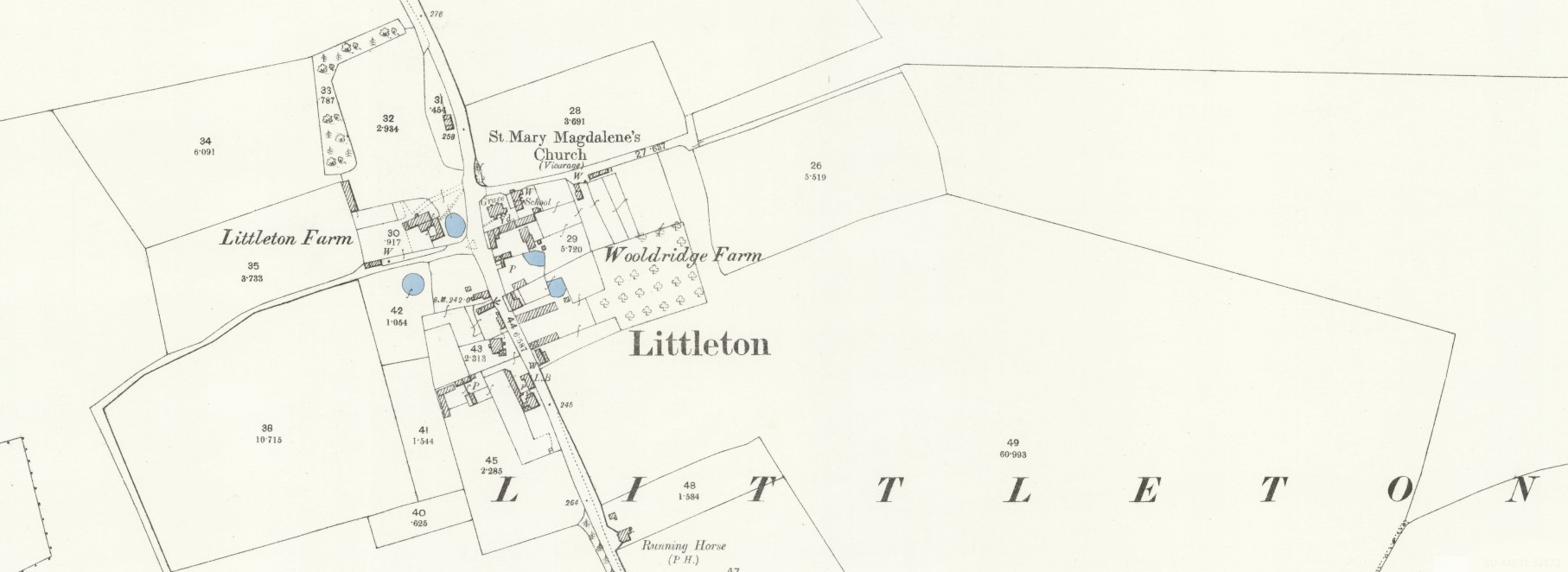 OS 25 Map Littleton - extract from Hampshire and Isle of Wight XL.8, Revised: 1894, Published: 1896
OS 25 Map Littleton - extract from Hampshire and Isle of Wight XL.8, Revised: 1894, Published: 1896
 OS 25 Map Littleton - extract from Hampshire and Isle of Wight XL.8, Revised: 1894, Published: 1896 - With Headbourne Worthy, Flower Down, Harestock Farm, Lainston House, Northwood Park, and Walnut House. Just off the map to the NW is Crawley
OS 25 Map Littleton - extract from Hampshire and Isle of Wight XL.8, Revised: 1894, Published: 1896 - With Headbourne Worthy, Flower Down, Harestock Farm, Lainston House, Northwood Park, and Walnut House. Just off the map to the NW is Crawley
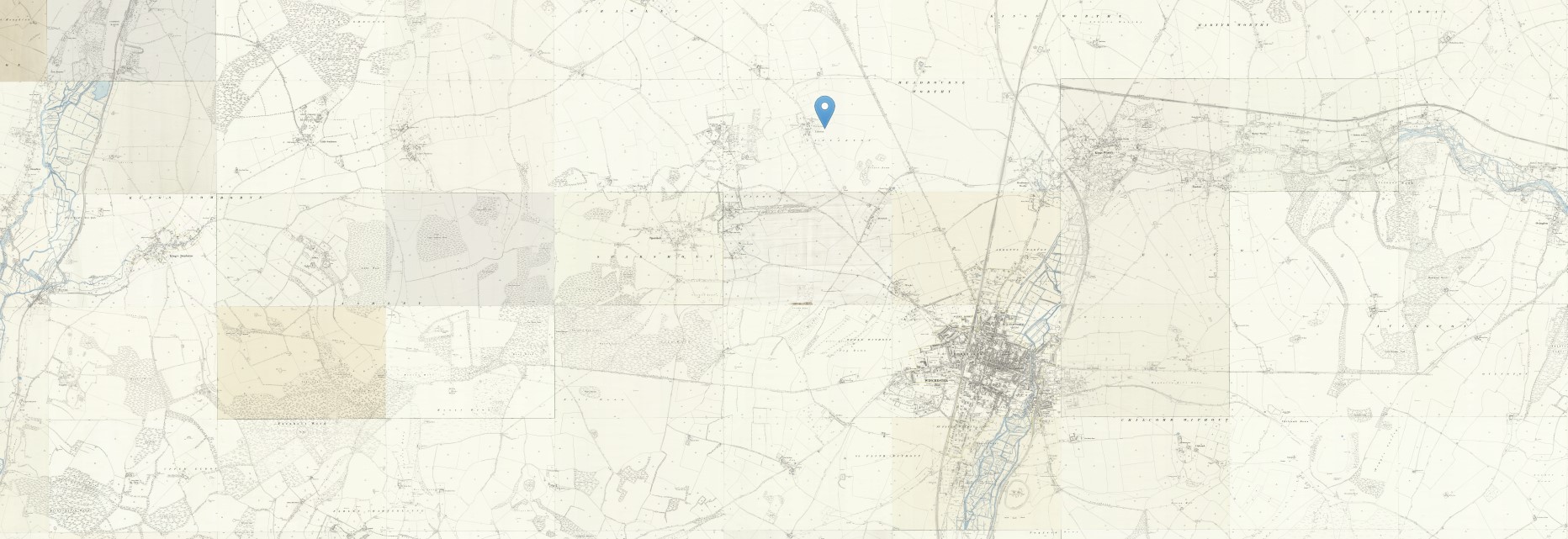 OS 25 Map - Littleton at marker with Winchester to the South
OS 25 Map - Littleton at marker with Winchester to the South
Right up to date with an embedded Google Maps with Littleton, and the route from there to Stanbridge and Romsey.
The route shown and timing is for a car, unfortunately there is not an option for any form of horse or horse drawn transport. A bicycle is however, a option and perhaps may nearly be equivalent, changing the driving time from 31mins on a route of 16.6 miles to a similar route on bicycle of 1hr 29min for 17 miles.
The walking route is different and takes 4 hrs 42 mins for 14.3 miles. Walking was the normal mode of transport for most people in 1654. Only a few people could afford using a horse and even less horses and carriage.
xxxx

